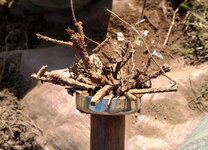austin_luker
Sr. Member
- Oct 17, 2014
- 425
- 420
- Detector(s) used
- XP Dues (AKA: EMI Chaser/Dog fence lover)
9" X35 - 11" LF - HF Elliptical - MI6 -
Garrett AT Pro with Neil Storm Coil, NEL SharpShooter and Garrett Pro PinPointer AT (Carrot)
- Primary Interest:
- Metal Detecting
So not much to do with the Dues but more towards how we use our machines to find things lost.
A friend of mine and I found a 1700 site close to the largest river in the northeast (won't give name of area) but we found the place was a carpet of square nails. I mean 20 nails per shovel full of dirt. So almost impossible to detect in any proper way. So what did we do to pull super old relics from the ground?
We dug 6 inches down and detected only the excavated dirt, dug another 8 inches down and hit that excavated dirt. We kept this process until dark, we both pulled over 30 small porciline buttons (underwear buttons) 2 large cents, 1 Indian head, and mound of flat buttons and 1 medicine bottle complete. We think some sort of dwelling has been here since 1700's and built on top of each other.
Anyone have any other ideas on how to pull all the finds from the area. We don't want to sift as digging with all the roots and rocks is enough work already!
Sent from my SM-G950U using Tapatalk
A friend of mine and I found a 1700 site close to the largest river in the northeast (won't give name of area) but we found the place was a carpet of square nails. I mean 20 nails per shovel full of dirt. So almost impossible to detect in any proper way. So what did we do to pull super old relics from the ground?
We dug 6 inches down and detected only the excavated dirt, dug another 8 inches down and hit that excavated dirt. We kept this process until dark, we both pulled over 30 small porciline buttons (underwear buttons) 2 large cents, 1 Indian head, and mound of flat buttons and 1 medicine bottle complete. We think some sort of dwelling has been here since 1700's and built on top of each other.
Anyone have any other ideas on how to pull all the finds from the area. We don't want to sift as digging with all the roots and rocks is enough work already!
Sent from my SM-G950U using Tapatalk



 Otherwise, it's muscle power! I built a classifier/sifter for dump sites. It has different size screens stacked up to filter out the rocks and big stuff. The bottom screen is small enough to keep most buttons from falling through, but, still allows the dirt to fall through easily. Clay is a different story! Ugh!
Otherwise, it's muscle power! I built a classifier/sifter for dump sites. It has different size screens stacked up to filter out the rocks and big stuff. The bottom screen is small enough to keep most buttons from falling through, but, still allows the dirt to fall through easily. Clay is a different story! Ugh!




